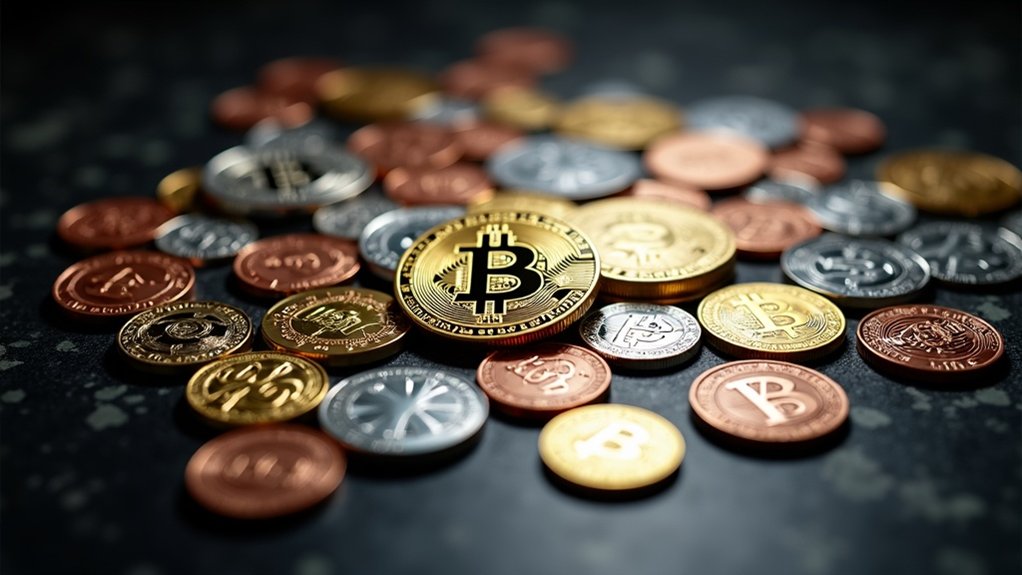Crypto volatility refers to those wild, sometimes nauseating price swings in digital currencies. Bitcoin might shoot up 10% before breakfast, then tank 15% by dinner. It’s caused by limited market liquidity, regulatory surprises, and let’s face it—emotional traders panicking on Twitter. This rollercoaster matters because it creates both profit opportunities and stomach-churning risks. Some love the adrenaline rush; others get financially destroyed. The crypto market isn’t for the faint of heart, but that’s precisely why it’s fascinating.
Why does crypto make investors feel like they’re on a rollercoaster without a seatbelt? Simple. Crypto volatility. It’s the wild price swings that can make you rich on Monday and broke by Friday. These digital assets fluctuate more dramatically than traditional markets, creating heart-stopping drops and exhilarating climbs that would make even seasoned Wall Street traders queasy.
Volatility measures how much an asset’s price changes over time. In crypto, these changes happen fast and furious. Bitcoin might jump 10% before breakfast and drop 15% before dinner. No warning. No apology. Just the market doing its thing.
Crypto doesn’t ask permission to wreck your portfolio or double your money. It just happens—usually before you’ve finished your coffee.
What causes this financial whiplash? Limited liquidity is a big culprit. When markets are shallow, even modest trades can send prices soaring or crashing. Liquidity pools help stabilize prices by providing deeper market liquidity for cryptocurrency trading pairs. Regulatory uncertainty doesn’t help either. One tweet from a government official about potential crypto regulations, and boom—market panic. News sensitivity in this space is off the charts. A single headline about a security breach can trigger a selling frenzy. Emotional trading by investors often leads to rapid value shifts in cryptocurrency markets. Market sentiment driven by investor emotions can dramatically impact cryptocurrency prices, especially when amplified through social media channels.
Measuring this chaos requires tools. Standard deviation is the go-to metric, showing how far prices stray from their average. The Bitcoin Volatility Index specifically tracks market fear. Average True Range compares current price movements to historical ones. Higher numbers? More volatility. Duh.
Compared to traditional markets, crypto is the hyperactive child in the room. Bitcoin has been three to four times more volatile than major stock indices since 2020. Yet, intriguingly, it’s sometimes less volatile than certain S&P 500 companies. Go figure.
For investors, this volatility is a double-edged sword. High risk, high reward. You can make fortunes during price surges or lose everything in crashes. It creates trading opportunities but makes long-term planning nearly impossible.
As the market matures with institutional money and ETF products flowing in, volatility has actually decreased. But let’s be real—crypto without some wild price action just wouldn’t be crypto. The rollercoaster is part of the appeal.
Frequently Asked Questions
How Do I Protect My Crypto Investments During High Volatility Periods?
Investors protect crypto during volatility through diversified portfolios—spreading risk across different cryptocurrencies and traditional assets.
They implement stop-loss orders to limit downside exposure when markets tank.
Dollar-cost averaging helps avoid timing disasters.
Smart traders use technical indicators like RSI and Bollinger Bands to spot entry/exit points.
The disciplined ones? They avoid leverage like the plague.
And emotion? That’s the real portfolio killer. Cold, calculated decisions win this game.
What Time of Day Typically Shows the Highest Crypto Volatility?
Highest crypto volatility typically occurs during the overlap between London and New York trading sessions (13:30-15:30 UTC). No surprise there.
This timeframe packs a punch with institutional players flooding in orders while European markets wrap up. The U.S. market open (13:30-16:00 UTC) is particularly wild.
Weekends and overnight Asian-Pacific hours (00:00-07:00 UTC) can also get crazy – less liquidity means bigger price swings when something happens.
Markets never sleep, neither does volatility.
Does Volatility Differ Between Established Cryptocurrencies and Newer Altcoins?
Yes, volatility differs drastically between established cryptocurrencies and newer altcoins.
Altcoins experience wilder price swings—often dramatically so. Why? Lower liquidity, smaller market caps, and fewer traders. When someone dumps $100K of an altcoin, markets feel it. Bitcoin and Ethereum? Barely a blip.
Altcoins also dance to sentiment’s tune more dramatically. A single tweet can send them soaring—or crashing.
Statistical studies confirm it: altcoins show higher daily volatility and more dramatic price jumps. Simple math, really.
Can Volatility Be Predicted Using Specific Technical Indicators?
Yes, technical indicators can predict crypto volatility with varying success.
Bollinger Bands expand during high volatility, while ATR directly measures it. RSI signals potential volatility through overbought/oversold conditions.
But here’s the kicker – they’re not foolproof.
Machine learning models actually outperform traditional indicators, especially when they incorporate sentiment analysis from news and social media. Combining multiple indicators typically works better than relying on just one.
No crystal ball here, folks.
How Do Exchange Outages Impact Cryptocurrency Volatility?
Exchange outages slam crypto markets with sudden liquidity shocks.
When major platforms go dark, trading volume plummets and bid-ask spreads widen dramatically.
Pretty obvious result? Volatility spikes.
Users can’t execute trades during downtime, creating pent-up demand that explodes when exchanges reopen.
Price discovery gets disrupted, causing stale pricing and market inefficiency.
These outages often coincide with already turbulent conditions—talk about bad timing.
The aftermath typically shows heightened volatility, fragmented pricing across platforms, and increased operational risks for traders.








